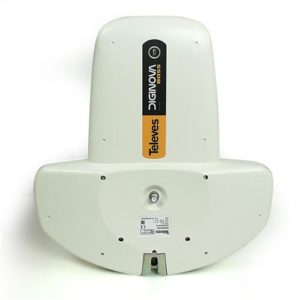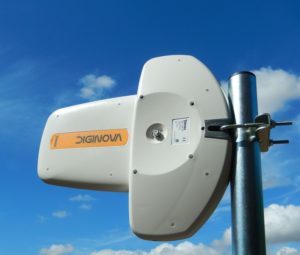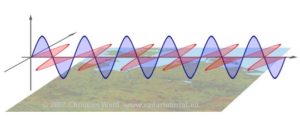A television antenna is actually a pretty simple thing. It has a lot of complex engineering, but when it comes down to it you’re talking about a length of metal pointing in the direction of the broadcast source.
What if that antenna weren’t pointed toward the towers? What if you pointed it straight up?
If you are talking about a Yagi-style (or log-periodic) antenna it probably wouldn’t make much difference if it were pointed straight up. It would make some difference but not perhaps enough to make a difference for you.
The elements in a log periodic antenna are designed to do two things. First of all each length of metal pole is custom-tailored to receive a specific frequency. Second, each element acts as a director for the antenna elements behind it. It actually focuses more signal to the elements behind it, which I think is a pretty cool thing.
If you pointed an antenna straight up then the elements would have a clear view of the sky but they wouldn’t act together. That would mean the antenna wouldn’t work as well but it would still work.

The same applies to more modern antennas. I’ve tested this DigiNova Boss pointing straight up and it did work. Signal levels were good but not as good as they were when pointing it properly.
You can’t turn an antenna 90 degrees and expect it to work. Here’s a photo of that same antenna. It shows what you cannot do.

Don’t do that.
Why? When it comes to antenna signals, we say they are polarized in a particular way. In other words the waves travel sideways or up and down. This graphic sort of shows what I’m talking about.

The blue signals are vertically polarized— they go up and down. The red ones are horizontally polarized— they go from side to side. In the US, all TV signals are horizontally polarized, which is why you have an antenna that sits flat in order to receive them. In other countries they are vertically polarized, which is how I got that other picture. (It’s from a Czech web site.)
If you turn an antenna on its side, it loses almost all the signal. I tried this with the Diginova and it performed really, really badly. So badly that there wasn’t any point to it.
Indoor antennas follow the same rules as outdoor ones. Even though I famously got great results with an indoor antenna under a cat, I still didn’t get the same results I got when using the antenna the way it was intended. With the antenna under the cat, the elements were still visible even though it was laying on its side. Indoor antennas don’t perform as well as outdoor ones anyway so it’s possible you might not notice the difference if you lay one down on its side.
If you’re really close to the towers you might actually get better results from laying an indoor antenna on its side because that might attenuate the signal. Of course, you have a lot of flexibility with indoor antennas because you don’t have to climb up on the roof to aim them.
Just put the antenna up the way it was designed, and aim it toward the towers. That’s usually your best bet.
If so, shop the great selection you’ll find at Solid Signal! If you’re not sure what you want, why not call the experts? We have antenna technicians on staff who are ready to take your call! Call us at 888-233-7563. We’re here during East Coast business hours. If it’s after hours, fill out the form below! We’ll get right back to you.
The post Would an antenna work if you pointed it straight up? appeared first on The Solid Signal Blog.
Continue reading...
What if that antenna weren’t pointed toward the towers? What if you pointed it straight up?
If you are talking about a Yagi-style (or log-periodic) antenna it probably wouldn’t make much difference if it were pointed straight up. It would make some difference but not perhaps enough to make a difference for you.
The elements in a log periodic antenna are designed to do two things. First of all each length of metal pole is custom-tailored to receive a specific frequency. Second, each element acts as a director for the antenna elements behind it. It actually focuses more signal to the elements behind it, which I think is a pretty cool thing.
If you pointed an antenna straight up then the elements would have a clear view of the sky but they wouldn’t act together. That would mean the antenna wouldn’t work as well but it would still work.

The same applies to more modern antennas. I’ve tested this DigiNova Boss pointing straight up and it did work. Signal levels were good but not as good as they were when pointing it properly.
Here’s what you can’t do
You can’t turn an antenna 90 degrees and expect it to work. Here’s a photo of that same antenna. It shows what you cannot do.

Don’t do that.
Why? When it comes to antenna signals, we say they are polarized in a particular way. In other words the waves travel sideways or up and down. This graphic sort of shows what I’m talking about.

The blue signals are vertically polarized— they go up and down. The red ones are horizontally polarized— they go from side to side. In the US, all TV signals are horizontally polarized, which is why you have an antenna that sits flat in order to receive them. In other countries they are vertically polarized, which is how I got that other picture. (It’s from a Czech web site.)
If you turn an antenna on its side, it loses almost all the signal. I tried this with the Diginova and it performed really, really badly. So badly that there wasn’t any point to it.
What about indoor antennas?
Indoor antennas follow the same rules as outdoor ones. Even though I famously got great results with an indoor antenna under a cat, I still didn’t get the same results I got when using the antenna the way it was intended. With the antenna under the cat, the elements were still visible even though it was laying on its side. Indoor antennas don’t perform as well as outdoor ones anyway so it’s possible you might not notice the difference if you lay one down on its side.
If you’re really close to the towers you might actually get better results from laying an indoor antenna on its side because that might attenuate the signal. Of course, you have a lot of flexibility with indoor antennas because you don’t have to climb up on the roof to aim them.
When in doubt…
Just put the antenna up the way it was designed, and aim it toward the towers. That’s usually your best bet.
Interested in getting a new antenna?
If so, shop the great selection you’ll find at Solid Signal! If you’re not sure what you want, why not call the experts? We have antenna technicians on staff who are ready to take your call! Call us at 888-233-7563. We’re here during East Coast business hours. If it’s after hours, fill out the form below! We’ll get right back to you.
The post Would an antenna work if you pointed it straight up? appeared first on The Solid Signal Blog.
Continue reading...

